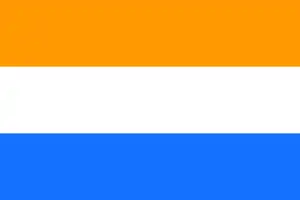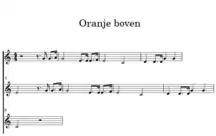Oranje boven (lit. 'Orange Above') is a Dutch pro-monarchy folk song which represents Dutch fondness for its royal family, the House of Orange-Nassau. It is a contrafact, sharing the same melody as the children's song "We zijn er bijna (lit. 'We are almost there')".
Origin

The song has its origins in the late 19th century, when Emma of Waldeck and Pyrmont became regent of the Netherlands(1890-1898).[1] The song soon grew in popularity especially during World War II, the song was frequently sung as a sign of resistance."Oranje boven" refers to the Prince's tricolour of Prince William the Silent which originated between (1588-1630) which was used as a symbol by the watergeuzen (lit. 'Sea Beggars') and later by those whose allegiance was with the dutch during the Eighty Years' War against Spain.[2][3] The tricolour became a symbol of freedom and dutch nationalism even after the orange was replaced by red with the Statenvlag[3] and many people still fly an orange pennon above the national flag on public holidays,[4] although the "prinsenvlag" in the modern day is seen as controversial in the modern day due to its use by the ,now defunct, far-right organisation "National Socialist Movement in the Netherlands" or "NSB"[5] which led to it becoming a symbol of the Dutch far-right.[6] Nevertheless, the song still sees moderate popularity and is often sung on Koningsdag (lit. 'King's Day')and Prinsjesdag (lit. 'Little Prince's Day' ), as well as during royal visits, and sporting events.

After the abdication of Queen Beatrix and the inauguration of King Willem-Alexander on 30 April 2013, for the first time in over 120 years a king sat on the dutch throne. The lyrics of the song were not appropriate for a male monarch, which led to a decline in its usage. Some alternatives to adapt to the male monarch have been suggested and implemented to some extent, such as "leve het koningspaar(lit. 'long live the royal couple')" to the original tune or, with the addition of a few notes, "leve de koning en de koningin (lit. 'long live the king and queen')".[7]
Lyrics
| Original text | English translation |
|---|---|
| Oranje boven,
Oranje boven, Leve de koningin! Leve de koningin! |
Orange above,
Orange above, Long live the queen! Long live the queen! |

Contrafact
Oranje boven is a contrafact of the children's song "We zijn er bijna" which "Oranje Boven" borrows its lyrical structure and melody."We zijn er bijna"s lyrics are shown below:
| Original text | English translation |
|---|---|
| We zijn er bijna,
we zijn er bijna Maar nog niet helemaal Maar nog niet helemaal |
We are almost there
We are almost there But not quite yet But not quite yet |
In popular culture
- The refrain of the song "Campione 2000" by Swedish musician E-Type, the official song of the UEFA Euro championship 2000 (organised in the Netherlands and Belgium) resembles to the chorus of "Oranje boven".
- Dutch actor, singer, writer and producer, Jon van Eerd released a comedy titled "Oranje boven".[8]
- Dutch comedian and celebrity André van Duin released a single called "Oranje boven" in February 2013 under his own management.[9] He used the original lyrics as the refrain although replacing the phrase "Leve de koningin" with "Leve de koning en Máxima" in connection to the abdication of Queen Beatrix.[10] The song was a commercial failure.
- Sophie Straat released a song for her album "Smartlap is Nied doot" released on the 3rd March 2023 called "Oranje boven"[11] it's critical of the dutch monarchy and especially the funding they get and calls for the dutch people to renounce the monarchy.[12]
References
- ↑ Redactie, Emma Wilhelmine Therese van Waldeck-Pyrmont, in: Digitaal Vrouwenlexicon van Nederland. URL: http://resources.huygens.knaw.nl/vrouwenlexicon/lemmata/data/Emma [24/03/2014]
- ↑ JC de Jonge, Geschiedenis van het Nederlandse zeewesen, deel 1. 's Gravenhage, 1833, p. 75.
- 1 2 Jean Rey, Histoire du drapeau, des couleurs et des insignes de la Monarchie française vol. 2, 1837, p. 515f.
- ↑ Poels, Jos (August 2011). "The Orange Pennant: The Dutch Response to a Flag Dilemma" (PDF). Proceedings of the 24th International Congress of Vexillology, Washington, D.C., USA: 888.
- ↑ "Prinsenvlag is omstreden, maar kent lange historie". Volkskrant (in Dutch).
- ↑ "Breaking: It's now 'illegal' to display the apartheid flag in South Africa". The South African. 2019-08-21.
- ↑ "Kinderliedjes met muziek O-P / melodietjes kinderlied - couplet en refrein, zingen, meezingen". kinderliedjes.overtuin (in Dutch).
- ↑ "Oranje Boven Trailer - YouTub". Youtube.
- ↑ "André van Duin – Oranje Boven (2013, 128 kbps, File) - Discogs". Discogs.
- ↑ "André van Duin - Oranje Boven (2013) (Videoclip) - YouTube". YouTube.
- ↑ "Smartlap Is Niet dood | Sophie Straat". Bandcamp.
- ↑ "Oranje Boven | Sophie Straat". Bandcamp (in Dutch).